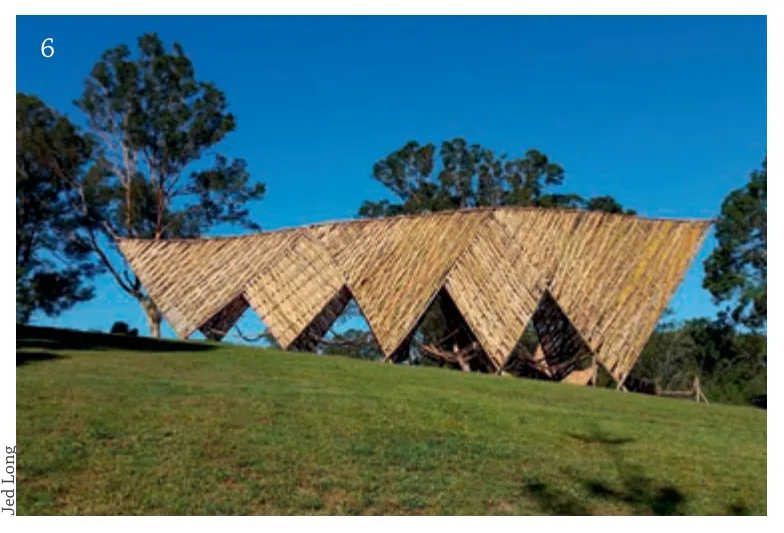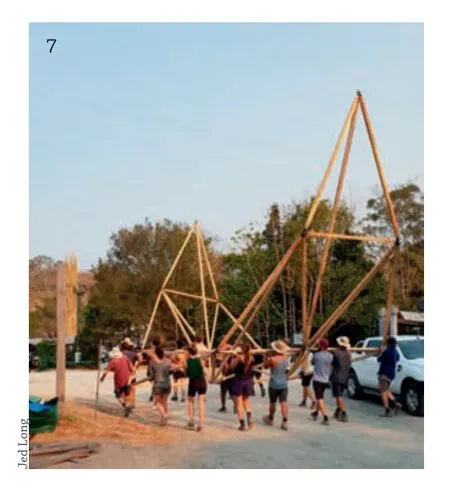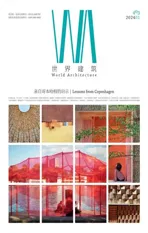与社区共同建造的Cave Urban设计工作室
2024-01-27杰德
杰德·朗
Cave Urban 是一个由艺术家、建筑师和设计师组成的位于悉尼的跨学科工作室,他们通过创作大型公共装置来探索艺术与建筑的交叉,重点关注社区参与、社区合作和生态设计。
Cave Urban 设计工作室的灵感来源于乡土建筑实践所蕴含的社会和文化仪式。他们开发了一种独特的设计和建造方式,将建造大型、半永久的公共装置的过程作为社区参与和知识传播的载体。为了践行联合国可持续发展目标第12 项的“负责任消费和生产”的理念,Cave Urban希望通过使用本地采购的可再生和可循环材料(尤其是本地的竹材),来减少项目对生态环境的影响。该工作室并不寻求通过建筑形式来实现建筑的永久性,而是希望通过与相关人员的合作和教育赋能,将本地的社会和文化遗产融入到每个项目中。
Cave Urban 设计工作室对合作的关注体现在两个层面:一是社区合作,通过师徒模式传递技能;二是技术合作,通过跨学科合作增长技术知识。澳大利亚是一个没有竹工艺历史的国家,因此Cave Urban 专门选择用竹材进行建造。同时,使用竹子建造也有利于通过知识技能的交流、森林系统的保护和低碳建筑材料的使用来增强社区的韧性。
位于澳大利亚昆士兰州伍德福德的项目就是Cave Urban 设计工作室利用竹子建造的一个试验场。在过去的 10 年中,Cave Urban 邀请了王文志、约尔格·斯塔姆等国际专家,通过社区参与和技能共享,合作建设了多个重要项目。作为一种轻质天然材料,竹子非常适合作为入门级的教育工具让人们接触建造实践,无论年龄、性别和技能高低,任何人都可以参与其中。
Cave Urban 设计工作室所创作的项目既是本地化的,也是国际性的。他们的作品直接回应本地环境,使用本地材料建造,与本地社区积极互动。他们在建造过程中与国际专家交流技术知识,并测试一些可以用于其他环境的创意。在专注于创作半永久性装置作品的过程中,Cave Urban 认识到建筑形式并不是永久的,装置的建造需要承担其应有的责任:尽可能地降低作品的生态成本,并创造可以超越装置物理寿命的社会和文化联系。

1 澳大利亚昆士兰水晶沟竹子农场 Crystal Waters bamboo farm,Queensland,Australia

6 吊床小屋,2017年 The Hammock Hut,2017

7 建构水荫巡游V2,2018年 Constructing Shade Parade V2,2018
Cave Urban is a Sydney-based multidisciplinary studio formed by artists,architects,and designers.Their practice explores the intersection of art and architecture by creating large-scale public installations,with an emphasis on community engagement,collaboration,and ecological design.
Inspired by the social and cultural ritual that is embedded within vernacular building practices,Cave Urban has developed a design and build methodology that utilises the construction of largescale semi-permanent interventions as a mechanism for community engagement and knowledge transfer.In alignment with SDG12: Responsible Consumption and Production,Cave Urban looks to limit the ecological impact of their projects through the use of locally sourced renewable and recycled materials,in particular self-harvested bamboo.Rather than seeking to create permanence through architectural form,Cave Urban looks to embed a social and cultural legacy in each project through the collaboration and educational empowerment of those involved.
Cave Urban's focus on collaboration occurs at two levels: community collaboration,sharing skills through a master/apprentice model and technical collaboration,developing technical knowledge through interdisciplinary partnerships.This is a direct response to working in Australia,a country with no history of bamboo craft and is a process that builds resilience through the exchange of knowledge and skills,as well as through the ongoing maintenance of forest systems and the use of low carbon building materials.
The Woodford site in Queensland,Australia,has served as a testing ground for this process.Over a period of 10 years,Cave Urban has invited international experts such as Wang Wen-Chi or Jorg Stamm to collaborate in the construction of ambitious projects made possible through community engagement and skills sharing.As a lightweight natural material,bamboo is well suited as an educational tool and introduction to construction practices allowing anyone to participate,regardless of age,gender,or skill set.
The outcomes of these projects are both local and international.The works created respond directly to place,using local materials and engaging with local community,while also exchanging technical knowledge with an international community of experts and testing ideas that can translate back to other contexts of use.By focusing upon the creation of semi-permanent work,Cave Urban acknowledges the impermanence of architectural form and the subsequent responsibility to minimise the ecological cost of a work and create social and cultural connections that extend beyond the physical lifespan of a structure.
